#A history of the vikings: children of ash and elm
Text

"...history is nothing if not a suppositional discipline, sometimes akin to a sort of speculative fiction of the past." - Neil Price
#A study post for people who's spaces aren't aesthetic#some of us are normal and only study at our very average houses#A history of the vikings: children of ash and elm#neil price#Yggdrasil#self esteem#studying#studyblr#aesthetic#aestheitcs#academic#academics
2 notes
·
View notes
Text
Strangely, Asgard also contained temples, cult buildings where the gods themselves made offerings—but to what or whom? The mythology of the Vikings is one of only a tiny handful in all world cultures in which the divinities also practised religion. It suggests something behind and beyond them, older and opaque, and not necessarily ‘Indo-European’ at all. There is no indication that the people of the Viking Age knew what it was any more than we do.
Neil Price, Children of Ash and Elm
#book quotes#children of ash and elm#norse mythology#vikings#norse#viking history#books and libraries#literature#books and reading#Neil price
72 notes
·
View notes
Text
"In a literal sense, the Vikings are of course people of the past, dead and gone—but at the same time they inhabit a curiously haptic kind of prehistory, one that appears to return whatever pressure is applied to it. Many have been tempted to put their fingers on the scales of hindsight and imagined that the impulse to do so came not from themselves but through the revelation of hidden truths buried by time. Medieval monks and scholars reinvented their pagan ancestors either as nobly misguided forebears or as agents of the devil. In the manuscript illuminations of Romance literature, with a kind of Orientalist prejudice, they became Saracens, enemies of Christ depicted with turbans and scimitars. In Shakespeare’s England, the Vikings were taken up as violent catalysts in the early story of the kingdom’s greatness. Rediscovered during the Enlightenment as a sort of ‘noble savage’, the figure of the Viking was enthusiastically adopted by the nationalist Romantics of the eighteenth and nineteenth centuries. Searching for their own emerging identities, Victorian imperialists scoured Scandinavian literature looking for suitably assertive northern role models, expressing the manifest destiny of the Anglo-Saxons through their Nordic cousins. The logical end of that trajectory came a century later, when the Nazis appropriated the Vikings in pursuit of their racist fictions, elevating them as a spurious Aryan archetype; their modern successors still plague us today. Elements of the broad Pagan community now seek a spiritual alternative that draws inspiration from Viking religion, with Tolkienesque flavourings added to a cloudier Old Norse brew. All these and many more, including today’s academics and the audiences for historical drama, have taken the fragmentary material and textual remains of the Vikings and recast them in moulds of their choosing. At times it can seem that the actual people have almost disappeared under the cumulative freight they have been made to bear."
- Neil Price, “Children of Ash and Elm: A History of the Vikings”
#history#norse history#vikings#viking age#viking history#neil price#children of ash and elm#this was a phenomenally detailed and comprehensive book#queue#mine
44 notes
·
View notes
Text
Odin, bisexual icon?
Source: Children of Ash and Elm: A History of the Vikings by Neil Price

6 notes
·
View notes
Text
Cooking implements have been most often been found in the graves of male vikings. Make of that what you will.
2 notes
·
View notes
Text
Children of Ash and Elm - Neil Price

Summary: A history of the Viking Age grounded in archeology and material culture that attempts to get at the lived experience of the Vikings.
Quote: “The Viking mind is far away from us today, but occasionally just about tangible.”
My rating: 4.5/5.0 Goodreads: 4.18/5.0
Review: Price’s clear and evocative writing could make any subject interesting, but the mysterious and strange world of the Vikings doesn’t need a lot of help. The book is enormous, covering death rituals, trade patterns, violence, gender, and crafting, for a start. No matter the subject, Price presents fascinating detail on the archeology and textual evidence that allow scholars to make informed guesses on how the Vikings experienced their world. He attempts to sketch out not just their physical landscape, but their mental and emotional one as well, never straying too far from the rigorous standard of evidence he has set himself.
The audiobook, read by Samuel Roukin, is long but brilliant.
1 note
·
View note
Text
List of interesting ressources pertaining to norse paganism, scandinavian folklore and history, and nordic religions in general
These are sources I have personally used in the context of my research, and which I've enjoyed and found useful. Please don’t mind if I missed this or that ressource, as for this post, I focused solely on my own preferences when it comes to research. I may add on to this list via reblog if other interesting sources come to my mind after this has been posted. Good luck on your research! And as always, my question box is open if you have any questions pertaining to my experiences and thoughts on paganism.
Mythology
The Viking Spirit: An Introduction to Norse Mythology and Religion
Dictionnary of Northern Mythology
The Prose and Poetic Eddas (online)
Grottasöngr: The Song of Grotti (online)
The Poetic Edda: Stories of the Norse Gods and Heroes
The Wanderer's Hávamál
The Song of Beowulf
Rauðúlfs Þáttr
The Penguin Book of Norse Myths: Gods of the Vikings (Kevin Crossley-Holland's are my favorite retellings)
Myths of the Norsemen From the Eddas and the Sagas (online) A source that's as old as the world, but still very complete and an interesting read.
The Elder Eddas of Saemung Sigfusson
Pocket Hávamál
Myths of the Pagan North: Gods of the Norsemen
Lore of the Vanir: A Brief Overview of the Vanir Gods
Anglo-Saxon and Norse Poems
Gods of the Ancient Northmen
Gods of the Ancient Northmen (online)
Two Icelandic Stories: Hreiðars Þáttr and Orms Þáttr
Two Icelandic Stories: Hreiðars Þáttr and Orms Þáttr (online)
Sagas
Two Sagas of Mythical Heroes: Hervor and Heidrek & Hrólf Kraki and His Champions (compiling the Hervarar saga ok Heiðreks and the Hrólfs saga kraka)
Icelandic Saga Database (website)
The Saga of the Jómsvíkings
The Heimskringla or the Chronicle of the Kings of Norway (online)
Stories and Ballads of the Far Past: Icelandic and Faroese
Heimskringla: History of the Kings of Norway
The Saga of the Volsungs: With the Saga of Ragnar Lothbrok
The Saga of the Volsungs (online) Interesting analysis, but this is another pretty old source.
The Story of the Volsungs (online) Morris and Magnusson translation
The Vinland Sagas
Hákon the Good's Saga (online)
History of religious practices
The Viking Way: Magic and Mind in Late Iron Age Scandinavia
Nordic Religions in the Viking Age
Agricola and Germania Tacitus' account of religion in nordic countries
Myths and Symbols in Pagan Europe: Early Scandinavian and Celtic Religions
Tacitus on Germany (online)
Scandinavia and the Viking Age
Viking Age Iceland
Landnámabók: Book of the Settlement of Iceland (online)
The Age of the Vikings
Gesta Danorum: The Danish History (Books I-IX)
The Sea Wolves: a History of the Vikings
The Viking World
Guta Lag: The Law of the Gotlanders (online)
The Pre-Christian Religions of the North This is a four-volume series I haven't read yet, but that I wish to acquire soon! It's the next research read I have planned.
Old Norse Folklore: Tradition, Innovation, and Performance in Medieval Scandinavia
Children of Ash and Elm: A History of the Vikings
The Penguin Historical Atlas of the Vikings by John Haywood
Landnámabók: Viking Settlers and Their Customs in Iceland
Nordic Tales: Folktales from Norway, Sweden, Finland, Iceland and Denmark For a little literary break from all the serious research! The stories are told in a way that can sometimes get repetitive, but it makes it easier to notice recurring patterns and themes within Scandinavian oral tradition.
Old Norse-Icelandic Literature: A Short Introduction
Saga Form, Oral Prehistory, and the Icelandic Social Context
An Early Meal: A Viking Age Cookbook and Culinary Oddyssey
Runes & Old Norse language
Uppland region runestones and their translations
Viking Language 1: Learn Old Norse, Runes, and Icelandic Sagas and Viking Language 2: The Old Norse Reader
Catalogue of the Manks Crosses with Runic Inscriptions
Old Norse - Old Icelandic: Concise Introduction to the Language of the Sagas
A Companion to Old Norse-Icelandic Literature and Culture
Nordic Runes: Understanding, Casting, and Interpreting the Ancient Viking Oracle
YouTube channels
Ocean Keltoi
Arith Härger
Old Halfdan
Jackson Crawford
Wolf the Red
Sigurboði Grétarsson
Grimfrost
(Reminder! The channel "The Wisdom of Odin", aka Jacob Toddson, is a known supporter of pseudo scientific theories and of the AFA, a folkist and white-supremacist organization, and he's been known to hold cult-like, dangerous rituals, as well as to use his UPG as truth and to ask for his followers to provide money for his building some kind of "real life viking hall", as supposedly asked to him by Óðinn himself. A source to avoid. But more on that here.)
Websites
The Troth
Norse Mythology for Smart People
Voluspa.org
Icelandic Saga Database
Skaldic Project
Life in Norway This is more of a tourist's ressources, but I find they publish loads of fascinating articles pertaining to Norway's history and its traditions.
#ressources#masterpost#heathenry#research#sources#norse paganism#norse gods#spirituality#polytheism#deity work#pagan#paganism#deities#norse polytheism#mythology#eddas#sagas
644 notes
·
View notes
Text
@nimblermortal sent me this last week:
A second blade weapon became increasingly common in the later Viking Age. It does not have a formal name, being often referred to as a fighting-knife or battle-knife, and it was essentially a development of the one-handed, long seax knife of the Migration Period. A single-edged blade with a thick back that added weight to a short, stabbing blow, it seems to have been intended as a back-up weapon. By the tenth century, battle-knives had elaborate scabbards that were worn horizontally along the belt, allowing them to be drawn across the body from behind a shield if the sword was gone; a variant hung down at an angle from an elaborate harness. It seems they may also have been worn on the back - again for a swift, over-the-shoulder draw.
Children of Ash and Elm by Neil Price
@petermorwood (Mr Morwood! Mr Morwood!) I found an archaeologist claiming people were doing over-the-shoulder draws! Would you care to weigh in?
*****
Would I ever! That's a button well pushed. But things got odd when I tried, because as soon as I'd written even the smallest reply and saved to Draft, this happened:

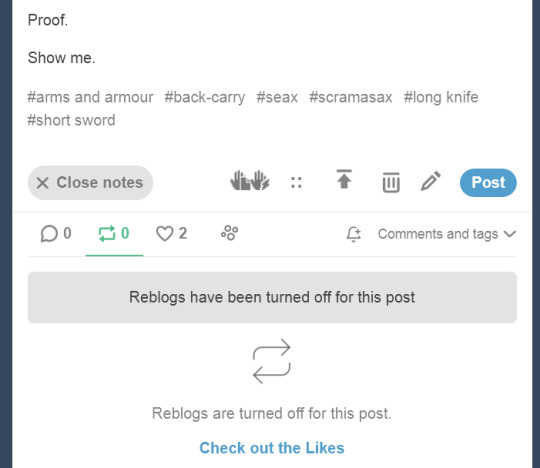
Letting it stand would have seemed like I was trying to avoid comments, corrections or criticism, but despite poking around in Settings there was no way to turn things on. It was only by cut-and-pasting @nimblermortal's entire original as a Quote starting a new post that the problem was resolved.
Anyone else encountered this?
Anyway, on with the lecture response. :->
*****
As regards Back-Carry / Back-Draw of "battle-knives", I'm not convinced.
("Battle-knife" is a term I've never seen in connection with any Viking Age weapon. What's the Old Norse for it? German "Kriegsmesser" (war-knife) refers to something much bigger from 500 years later, also not back-carried or back-drawn - which from here on will be BD / BC.)
To get where he is now, a full professor, Neil Price will have defended his PhD, and should know such a statement as "It seems they may..." will need evidence to support it.
That phrase is easy to write, as is "According to legend..." and "It is said..." However these are IMO default History Channel phrases, with all the authenticity that implies. None of them actually PROVE what they're speculating.
"Experiments conducted by museum staff wearing authentic armour reveal that IT SEEMS medieval knights could use smartphones."
But does it prove medieval knights USED smartphones? See what I mean?
*****
I first asked if anyone had actual proof of BC / BD on Netsword almost 30 years ago, and to date there's been nothing. I've also posted about it quite a lot on Tumblr, so being poked with this particular stick is no surprise. :->
The quotation from "Children of Ash and Elm" is the first time I've heard of a trained archaeologist making a claim for BC / BD, and the odd part is that Prof. Price also states the weapon was intended for "...a short, stabbing blow" - which means wearing it horizontally in front makes far more sense. From that position it can be drawn far faster and with less telegraphed intent than "...on the back - again for a swift, over-the-shoulder draw."
Reaching up for any weapon carried across the back, whether long or short, is a bigger movement - and thus less "swift" - than snatching out the same weapon worn at the hip or across the front at waist level, especially if - as he suggests - that move is masked behind a shield (or for that matter a cloak, a door, or a half-turned torso...)
Try both moves in front of a mirror with a ruler or even a length of dowel, and you'll understand.
With a weapon-hilt visible behind one shoulder or just a cross-belt suggesting something slung out of sight, what's a Norse warrior going to think when his potential opponent reaches up there? At a moment of hot words and high tension, will he wait while an itchy back gets scratched or until an attack happens?
The explosive violence described in sagas suggests not.
If Prof. Price has solid proof for his BC / BD notion in the form of artefacts or art - and it'll need more than a one-off example - I'll be very pleased to finally see some "show me" evidence.
(It won't do anything for longswords of 500 years later, of course, though I bet the uncritical back-carry brigade would leap on it regardless.)
But without that evidence, I'm taking "it seems" with a wary pinch of salt.
*****
There's a weird internet fixation about BC / BD (which are NOT the same thing) and an equally weird need to show that back-draw "works", whether with hooks under the guard and a leather condom at the point...

... or by being open most of the way down one side.

Neither are real-world historical, so let's see how they work in fantasy.
IMO they're not appropriate there either, because the designers are so eager to provide working BC / BD that they ignore the main function of a scabbard, which is to carry the weapon in something which protects people from the weapon's edges, and the weapon from the elements.
Real scabbards for real swords went to some trouble over that. They protected people, including the wearer, with a completely enclosed wooden, leather and / or metal case, and protected the blades by having them fit into their case well enough that inclement weather stayed out.
This fitting could involve metal collars (Japanese habaki), or tight-gripping lanolin-rich fleece linings, or leather flaps, caps and rain-guards mounted on hilt or scabbard-throat. Real scabbards didn't have exposed metal and weren't open-sided rainfall buckets, because the priorities of actual sword users were very different to those of back-carry fans.
Given the number of posts I've seen about the technical side of fantasy world-building - history, geography, even geology and meteorology - I think this difference is worth noting.
*****
The first time I recall seeing back-carry mentioned in a historical-not-fantasy context was in "Growing Up in the Thirteenth Century", © Alfred Duggan 1962. Here's the extract in question:
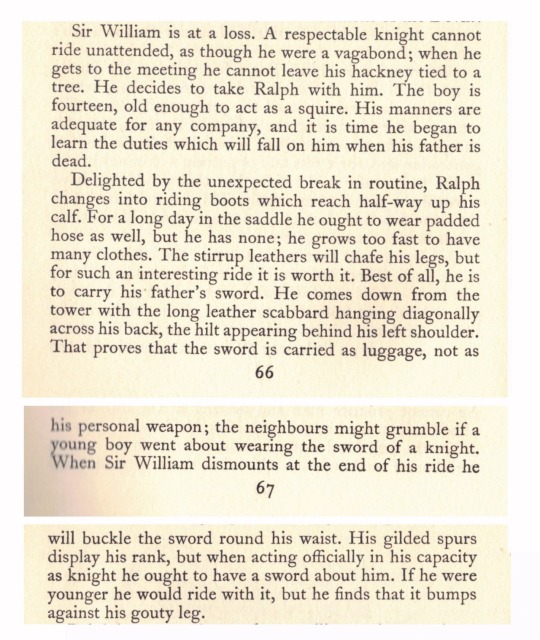
Unfortunately Duggan - though according to his Wikipedia entry "His novels are known for meticulous historical research" - doesn't give any cited source for this; his introduction to the book says:

I know the feeling! :->
I'd still trust him more than some modern historical writers who seem over-willing to add a touch of fantasy speculation / interpretation if it rounds out something inconclusive, makes the history more interesting or chimes with a personal agenda.
"Accurate" is better than "interesting", and "I don't know" is better than making stuff up.
*****
To repeat: I've yet to see any museum-exhibit or manuscript-illumination examples of BC / BD ever done For Historically Real with Western European swords, especially the hand-and-a-half longswords on which modern back-draw fans seem fixated.
A seax, scramasax or just plan sax is shorter, but yet again, this is the first time I've read anything even remotely scholarly about them or their later Viking-age version (saxes were associated more with Saxons than Vikings, guess why?) being BC / BD.
By contrast, there are at least three art instances of saxes worn horizontally, on 10th century crosses at Middleton Church, Yorkshire:

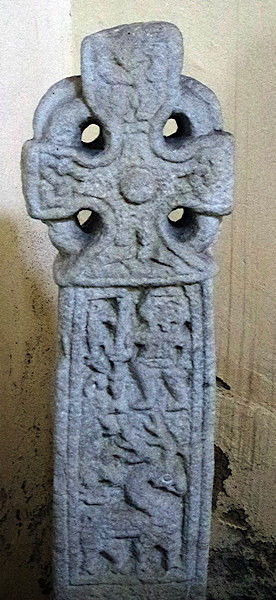
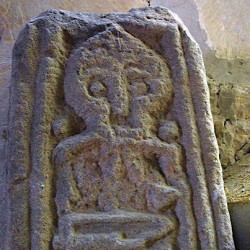
The art is backed up by surviving examples with scabbard-fittings still in place, indicating how they were worn. Here's one example, from the Metropolitan Museum, New York which makes that very obvious.
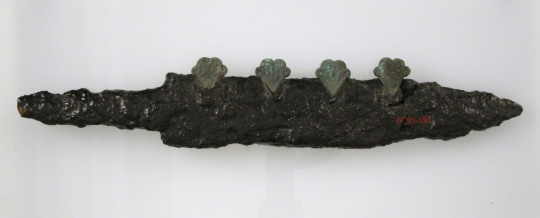
The little decorative masks (originally part of the top of the scabbard, now corroded onto the blade) are clearly meant to be This Side Up, and also show that this scabbard was This Side Out for a right-handed draw, since there's no detail on the back.

There's a similar fancy-front / plain-back / right-hand-use leather sax scabbard at the Jorvik Centre in York.
There's only a single photograph of this bigger one - 54cm (21.5 in) overall - from the Cleveland Museum of Art, with no way to see if the L-shaped scabbard mount is decorated on just one or both sides. However it does indicate the weapon was meant for horizontal wear.
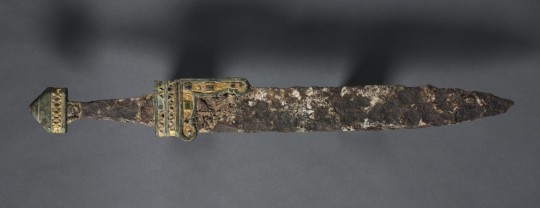
I've also flipped the website photo to show right-hand use, because "It seems..." (hah!) more probable. Here's why I did it:
For most of history being left-handed was unusual, a disapproved-of aberration and the origin of the word sinister.
Left-handers were useless in any formation from Ancient Greece through Ancient Rome to the Saxon and Viking period where the shields of a phalanx, testudo or shield-wall had to overlap for mutual support.
In the Middle Ages, both the specialised armour and the layout of jousting courses were almost 100% right-hand only.
Most surviving swords with asymmetrical hilts, such as swept-hilt rapiers, are made to for right hands not left.
Even nowadays many weapons - including the current British Army rifle (SA-80 / L85/A2) - are set for right-handers only.
*****
The longest saxes are called Langseax (surprise) though this may be a modern-ish term. Here's one from the British Museum, the so-called "Seax of Beagnoth"...

...which is 72 cm (28.5 in) total / 55cm (22 in) blade.
That's about the same as a Roman gladius (another sword never back-worn despite its convenient size) and is a good 25-30cm (10-12 in) shorter than the average "proper" sword of the same period, which means it could be drawn over-shoulder...
However the layout of its runic engraving shows it was almost certainly meant to be worn horizontally As Per Usual.
*****
And now we've come all the way back around to Prof. Price's claim that Vikings did BC / BD with their battle-knives.
Such a claim needs proof.
Please, show me some.
#arms and armour#back-carry#seax#scramasax#long knife#short sword#left-handed weapons#research#evidence
80 notes
·
View notes
Text

a very particular joy and also deep thoughts of various varieties are stored in this passage from neil price's "children of ash and elm: a history of the vikings"
28 notes
·
View notes
Text
Sometimes it's fun to solicit the opinions of the Tumblr community, so here's a pointless little poll to help me make up my mind.
9 notes
·
View notes
Text
Book Review of 'A History of the Vikings: Children of Ash and Elm' by Neil Price

This is probably singlehandedly one of the best academic books I've read as a pagan addressing the Viking era and its people's.
The author did a PHENOMENAL job of using academic sources (archaeology, literature, historical linguistics, etc) to really paint a living picture of the peoples being discussed in their entirety. The author left room for the peoples spiritual/supernatural believes that I don't often see done by writers who are not writing specifically for a pagan audience.
It was deeply refreshing and I sincerely hope to see more academic authors following in their footsteps in the years to come
#pagan#paganism#paganblr#norse#norse paganism#norse polytheism#scandinavian#Scandinavian paganism#Scandinavian polytheism#vikings#viking era#book#books#book review#Neil Price#children of ash and elm#blackcrowing
91 notes
·
View notes
Text
Sitting on the bus on my way to my top surgery pre-assessment feeling absolutely devastated because I've just (finally, after many months) finished reading The Children of Ash and Elm: A History of the Vikings. I am wrecked. I have so much to think about. I spent like five minutes just sitting there with a thousand mile stare trying not to cry because the book finished by talking about the children's toys preserved in the archeological record and I simply cannot cope with this at 8:56 AM on a Thursday morning
12 notes
·
View notes
Text
@cafeleningrad tagged me to name 23 books I read in 2023 and my only coping mechanisms are sex and research so whoooooo I've got all 23 and they were hard to pick.
Vinland Saga by Makoto Yukimura.
The Polar Bear Expedition: The Heroes of America's Forgotten Invasion of Russia, 1918-1919 by James Carl Nelson
The Sum of Us by Heather McGee
Dark Archives: A Librarian's Investigation Into the Science and History of Books Bound in Human Skin by Megan Rosenbloom
Intimate Matters: A History of Sexuality in America by John D'Emilio and Estelle B. Freedman
The Anglo-Saxons: A History of the Beginnings of England: 400 – 1066 by Marc Morris
Sex, Soldiers and the South Pacific, 1939-45: Queer Identities in Australia in the Second World War by Yorick Smaal
Stolen Focus: Why You Can't Pay Attention—and How to Think Deeply Again by Johann Hari
A History of New Zealand in 100 Objects by Jock Phillips
Dispossessed Lives: Enslaved Women, Violence, and the Archive by Marisa J. Fuentes.
Children of Ash and Elm: A History of the Vikings by Neil Price
Cafe Neandertal: Excavating Our Past in One of Europe's Most Ancient Places by Beebe Bahrami
Albion's Seed: Four British Folkways in America by David Hackett Fischer
1945: The Year That Made Modern Canada by Ken Cuthbertson
The Library: A Fragile History by Andrew Pettegree & Arthur der Weduwen
The Anarchy: The Relentless Rise of the East India Company by William Dalrymple.
A History of Nigeria by Toyin Falola
Embracing Defeat: Japan in the Wake of World War II by John W. Dower
Fire and Blood: A History of Mexico by TR Fehrenbach.
A History of New Zealand Women by Barbara Brookes.
A History of Disability By Henri-Jacques Stiker
Mosquito Soldiers: Malaria, Yellow Fever, and the Course of the American Civil War by Andrew Bell
Revels in Madness: Insanity in Medicine and Literature by Allen Thiher
tagging @elfpen an anyone else who'd like to participate! give me those fiction recommendations because i anxiety read non-fiction lmao.
15 notes
·
View notes
Text
Okay, so background, first I gotta crosspost this from Pillowfort, when someone asked me for "my" medieval Scandinavia rant
The biggest ones currently are about the eruption of that one volcano in El Salvador; the way you can get a sense for when a scribe had a break (or really needed one) from copying their work; and the idea of writing as a public vs private work vis-a-vis runestones.
The first and last being because I have just discovered Neil Price and I am in scholarly love. I am adding him to my harem. Perhaps a step behind Shannon entropy and the marine reservoir effect, which is its own medieval Scandinavia rant.
So let's talk about writing as a public practice, which is drawing on Price's description of literacy in Children of Ash and Elm, the chapter The Performance of Power, around page 193 in my copy, because I have a copy now, because as soon as I returned my library copy I went and asked the bookstore to order one for me.
Price is coming at the subject of literacy as an archaeologist*, and notes that we have found many thousands of runic inscriptions - wait. Back up.
Saga Thing talked some months or years ago about literacy in the viking age, and how we have a lot of runestones, but we don't have books, and this doesn't actually give us an idea of how literate people were. If they were writing on very degradable things like, say, cheese, we would have no idea. Maybe all women signed their cheese! We wouldn't know! And they also noted that one common find in viking** burials is an amulet with the runes "alu," meaning ale. Which, if that ain't the most frat boy thing. And of course it is, because the demographic of vikings was exactly the demographic of frat boys! Young men, upper teens to twenties, from rich families, away from home for the first time, showing off for each other, forming insuperable bonds...
Anyway, so there's one way to look at literacy. Price notes that we have thousands of runic inscriptions, mostly on runestones, mostly as commemorations of the dead BUT in the mid-twentieth century excavations in Bergen and Trondheim, harbor towns, discovered thousands of small wooden slips inscribed with runes that had been preserved in the water. And these were covered in writing about stupid crap. Day-to-day life - shopping lists, dick jokes, "Sigmund owns this sack," apologies for not getting one's chores done... Price concludes "Not everyone was literate, but a lot of people obviously were, perhaps even children."
So now we get a little bit into the realm of speculation. Here is a people with a largely literate populace, who are regularly encountering literate cultures that produce books. They're raiding monasteries from 793! They have seen gospels. So what stops them from writing their own?
Well... it just. Didn't suit their needs. They needed shopping lists and name tags, and big public monuments indicating how rich they are, for the sake of the dearly departed of course. They weren't people who sat down and read, which of course wasn't a thing in Europe for centuries yet - note the history of the novel in Europe and the parallel to the advent of lounging furniture - but relatively-southern Europe at least had a class of people to do it for them. When we're looking at eighth to eleventh century Scandinavia, there aren't monasteries full of monks writing prayerbooks yet.
Because a book is inherently a private thing, which one person reads at a time, even if they read it aloud to a party. A runestone is inherently a public thing, which everyone passing notices and, if they're bored from walking for the past few hours, stops to read. So it's not a big leap from writing in stone with a chisel to writing on paper with a quill, but... there's no cultural reason to do so.
Never mind all of the fascinating ways that writing can happen on a runestone, such that it's notable when there's one written left to right and up to down in a rectangular block of text. (Bro church runestone, my beloved!)
...and I picked this rant because I thought it would probably be shorter.
*he led! the team that re-sexed the Birka warrior!
**which is a profession, not an ethnicity - it's a bit of a summer job for young men, like camp counselor but more violent
--------
Addendum: The Bro church runestone is my beloved not because I know enough runestones to justify the opinion, but because it's the one I've translated, and I love the way it's written. (I have only read/translated the one, but it would be a fun project. It's #617, so there's enough to keep me busy for a while, but they're usually short. It was also probably chosen for my textbook for being complete and clear.)
Anyway, the picture above shows how it's laid out. There's a curling arch over the top that reads, "Ginnlaug, Holmgeir's daughter, sister of Sigurd and of Gaut and his brothers, had this bridge built and raised this stone for her husband Ozur."
The part that drives me nuts is the loop below that: "Son of Earl Hakon, he was a viking watchman with [gæti]. God help his spirit and soul now." But the fact that it's written in a loop means it starts again the instant it stops: "God help his spirit and soul now, son of Earl Hakon, he was a viking watchman..." So the format in some sense makes it an infinite prayer in a way you can't do with textbook writing.
And maybe you can with graphic design, and certainly runestones are closer to works of art than to books, but. The options this sort of freedom opens up make me a little bit crazy.
Beyond, you know, the general medieval Scandinavia special interest crazy.
3 notes
·
View notes
Text
★ get to know me tag ! ✨
tagged by @scuderia-leclerc - thank u! 💗
last song - out of reach by gabrielle (random 90s playlists my beloved)
favourite colour - purple, dark green
currently watching - schitt's creek, comfort rewatch!
last movie - couldn't tell ya. i genuinely never watch movies
sweet / spicy / savoury - savoury! 🍽️🤤
relationship status - single
current obsession - i'm going to new york for the first time in like 2 weeks and i'm obsessed with the idea of ny in the autumn and also buying all the things i need for the trip and the long ass flight, and i just need to make it through these last 2 weeks of work before i goooo 🙏
last thing googled - there's a book about the history of the vikings called "children of ash and elm" that i'm interested in so i googled to find the cheapest way/format to get it lol
⚡ tagging - i'll tag the last 5 people currently in my notifs which are @aflowerofwords @maudedickpump @icantaffordacabbage @lewisroscoelove @hamiltonleclerc + anyone else who wants to!
7 notes
·
View notes
Quote
The nine stone packings at Götavi also raise an important and recurring component of the Viking mind: the sacred number. Nine - and its square root, three - appears numerous times in the mythological tales of the Norse. The sea-deities Aegir and Rán have nine daughters, the spirits of the waves; Heimdall has nine mothers; the giant Baugi has nine thralls; the beautiful Menglod has nine attendants; Gróa has nine protective charms; Odin has eighteen spells - twice nine; Thrivaldi, another giant who is slain by Thor, has nine heads. Freyr waits for his lover and later wife, Gerthr, for nine nights, the same length of time that Odin hangs on the tree in self-sacrifice, and sweats between the fires in 'Grímnir's Sayings', and makes his long ride to Hel on Sleipnir. In Valhöll, on every ninth night eight rings drop from the great gold ring, Draupnir (thus making nine in all), the source of Odin's wealth. The Muspell princess Laegjárn has a chest that must be closed with nine locks, one by one. The list goes on and on, and is replicated in the human world of Midgard: according to Adam [of Bremen] the great sacrifices at Uppsala last for nine days and are held every nine years, and nine creatures of each kind are killed. (In assessing the veracity of Adam's text, by the way, one might ask how he could have invented just that little detail to fit so well with wider picture he could not have known about.)
Neil Price, from Chapter 7 of “The Children of Ash & Elm | A History of the Vikings”, Penguin Books, 2020
14 notes
·
View notes